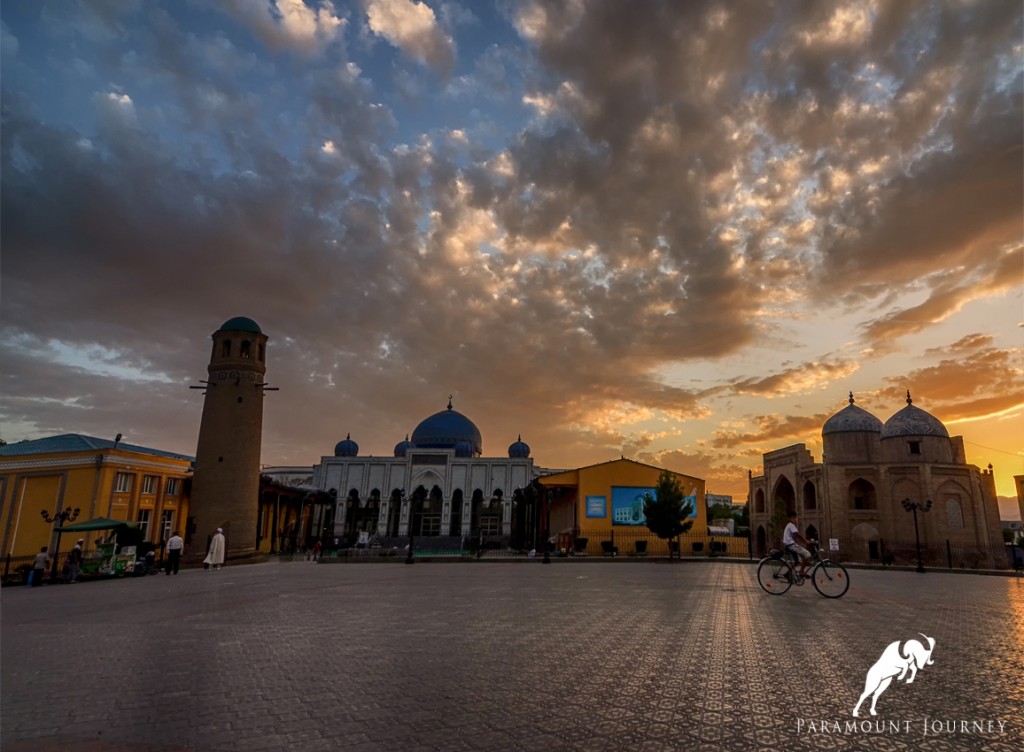As one of the oldest cities in Central Asia, conquested by Alexander the Great in the 4th century BC and renamed to Alexandria Eskhata, current-day Khujand (formerly known as Leninobod) functions as the northern capital of Tajikistan.
Situated on the Syr Darya River at the mouth of the Fergana Valley from where it connects Samarkand with the Fergana Valley, its favorable location allowed Khujand to develop into an important center of trade, industry and agriculture. Surrounded by wonderful apricot gardens, the blossoms change the gloomy winter mood into cheerful in spring.
1. What to do?
Panjshanbe market and Registan square
The Khujand Registan square is flanked by the central Panjshanbe market on one side and the mosque and mausoleum of Sheikh Muslihiddin from the other. In front stands the memorial to the Solders of World War II.
The Panjshanbe market is where you can feel the pulse of the city. The market attracts customers and tourists with it tremendous size, colorful design and abundance of goods at low, low prices. All strata of Tajik society browse the stalls here, and in season, the produce on offer is a culinary delight.
Khujand Fortress and Historical Museum of the Sughd Region
The fortress was destroyed and built up several times over, witnessing the invasions of Alexander the Great and the Arabic, Mongolian and Russian armies. Architecture has suffered a lot in Tajikistan under the current rulers, and the botched restoration of the fortress is another proof of that.
Inside the fortress there is a Museum of Archaeology and Fortification where dioramas of the Stone Age and Iron Age as well as archeological findings and collection of artifacts from Sughd region are displayed. Entrance fee is 10 somoni, no guide in English available and entrance to the actual fortress is not allowed since it is still in use as a military base. In front of the museum stands the Kamoli Khujandi Theater.
Statues of outstanding Tajiks
Go look for some of the statues around town and learn the history of the men on display. There are statues of poets like Rudaki and Kamoli Khujandi who contributed greatly to Tajik-Persian literature, Statue of commander Temurmalik placed inside of museum who has attempted to protect the city from Mongolians and Ismoili Somoni statue (40°17’43.38″N; 69°36’56.49″E) placed instead of Lenin statue.
Apricots
Apricot is considered as the brand of Khujand e.g. there is very sweet variety of apricot called Candy that growth only in the territory of this city.
Mahalas
One can still find traditional districts called mahalas in the old town of Khujand. Essential wandering territory. Razok Mahala is like a labyrinth, with some houses built from raw brick. In Maschidi Surkh Mahala some parts of the old town wall remain.
2. Around Khujand
Arbob Palace
One of the most interesting examples of Soviet neo-classical architecture in Tajikistan, Arbob Palace is a symbolic bridge between the history of Soviet Tajikistan and that of independent Tajikistan.
The construction of Arbob palace (40°16’14.17″N; 69°41’27.14″E) was initiated in 1950 by Urunkhujaev, the leader of the collective farm of which Arbob palace was soon to be the communal hall. Urunkhujaev was impressed by the Peterhof palace in St. Petersburg and recreated its winter garden palaces in his collective farm. Inside, classical western architecture blends beautifully with traditional Tajik decorative arts.
From the large auditorium and the VIP tearooms with artful parquet floors down to the corridors with glorious painted ceilings, no single space fails to impress.
In the 90’s, the palace had its rendez-vous with history as the place where the Tajik independence was written and a flag was decided upon, and years later, as the site where the “plov of peace” was eaten that started the reconciliation process between the warring sides in the civil war.
Entrance to the museum, with displays on the history of Arbob and the larger Soviet period, and a special focus on the tragic period of collectivisation in Tajikistan is 10 somoni. No guide in English is available. To the right of the palace you will find a huge new teahouse that can seat 200 people.
Lake Kayrokkum is an artificial reservoir located 15 km east of Khujand. It’s popular among locals as a holiday destination with decent resorts. You might even prefer to stay here instead of in a hotel in Khujand for the same price, and get some wellness treatment in the sanatorium.
3. Where to eat & drink
Khujand is an appropriate place to discover the traditional Tajik cuisine.
Visol
One of the few places in Khujand where you can actually order everything that’s on the menu. Locals enjoy the food, drinks and the service but not the price. There are several Visol cafes and restaurants in the city.
Zaytun
Zaytun is decorated in a traditional Tajik style and the menu mainly consists of Tajik meals. An appropriate place to explore Tajik cuisine and interior decorating. It’s less expensive than Visol, but not cheap as Bahor. There are 2 Zaytuns.
Bahor
If you’re looking for something cheap but decent, Bahor is yours for lunch and dinner. Still too expensive? The cheapest places can be found around Panjshanbe bazaar but picky travelers may not enjoy the surroundings.
Azizon
Another beautiful teahouse-restaurant in Khujand, located behind the memorial to the Soldiers of World War II.










